|
MONS PEAK TIGER PAW 075 TREKKING POLES
TEST SERIES BY ROBB PRATT
LONG-TERM REPORT
September 16, 2018
CLICK HERE TO SKIP TO THE FIELD REPORT
CLICK HERE TO SKIP TO THE LONG-TERM REPORT
TESTER INFORMATION
|
NAME:
|
Robb Pratt
|
|
EMAIL:
|
unicornv007 AT yahoo.com
|
|
AGE:
|
47
|
|
LOCATION:
|
Canton, Michigan, USA
|
|
GENDER:
|
M
|
|
HEIGHT:
|
5' 10" (1.80 m)
|
|
WEIGHT:
|
165 lb (74.80 kg)
|
I backpacked sporadically growing up and rediscovered it back in 2011. Since then, I've taken several weekend long trips a year. I also car camp with my family roughly a dozen nights a year when we use tents unless I can convince them I might snore and it would be better for all for me to use my hammock rig. I prefer a light pack (weight without food or water under 20 pounds / 9 kg). My backpacking stomping ground is northern Michigan that has small hills and I typically camp late spring, summer and early fall months.
INITIAL REPORT
PRODUCT INFORMATION & SPECIFICATIONS
Manufacturer: Mons Peak IX, LLC
Year of manufacture: 2018
Website: https://www.monspeakix.com
Listed weight: 17.3 oz (490 g) per pair
Weight as delivered: 17.3 oz (490 g) per pair
* Poles by themselves: 19.4 oz (550 g)
* Snow Baskets: 0.67 oz (19 g) per pair
* Rubber Tips: 0.63 oz (18 g) per pair
Dimensions: 24.5 to 53.1 in (62 - 135 cm)
MSRP: US $94.95
Product description: These are four season trekking poles made of Aircraft Grade 7075 hard anodized jet-black aluminum telescoping tubes. Tube length is adjusted using a pair of snap-click compression locks that are then tightened down with a few quick hand-turns of a small screw on the other side. Hand grips are made of cork though the lower extension and top are made of an elastomer. Silver markings and brand markings along the poles make them more visible in low lighting. They come with carbide tips, rubber tips, performance baskets and snow baskets. Wrist straps also come connected to the handles.
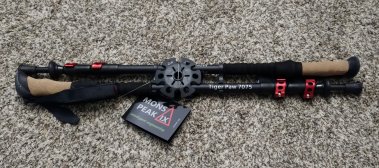 | | Initial Package |
INITIAL IMPRESSIONS
I excitedly received these shortly before my first backpacking trip of the season and felt just like a kid on Christmas morning. Although it was only a box and plastic bag to open they were well packaged inside.
The poles were laid opposite each other with a snow basket placed on both sides and the TIGER PAWS 7075 branding staring prominently at me. A pair of plastic (disposable) clips held them firmly in place. I'm not a packaging engineer, but it was evident that someone had taken some time and thought to make these look very presentable.
After removing the tags and separating the poles, I examined the construction. The poles themselves felt very smooth to the touch. No rough or jagged edges. Furthermore, the finish looks very clean and free of any defects such as chemical spotting, streaking or blemishing that can sometimes occur during the anodizing process.
The snow baskets are made of a thin, extruded plastic. I couldn't find any evidence of embedded contaminates or voids. Fabrication of the snow baskets was very clean; I had to search for the parting lines of the molds which were underneath. Side note - yes, I'm an engineer. It appears my engineering hat is leaking a bit today. I'll try to be less engineering-ish.
The rubber tip "thingies" fit tight over the carbide tips giving me confidence they will not fall off during use. I even tried flicking them off the end of the poles. They didn't come off, which is a good thing because they would have bounced along the carpet and either been eaten by my dog or turned into an impromptu cat toy and subsequently buried under the refrigerator.
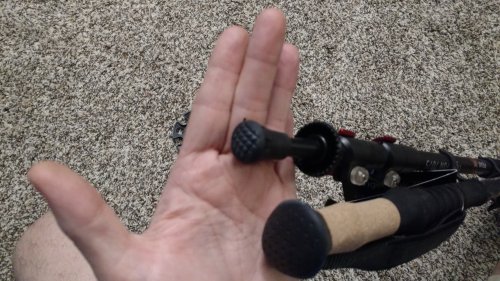 | | Rubber Tip |
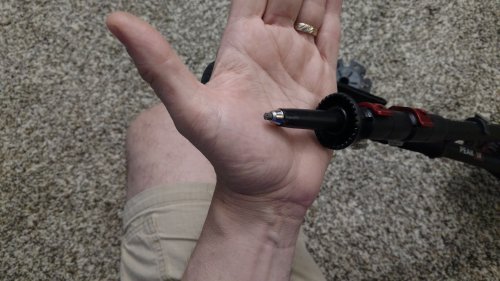 | | Carbide Tip |
The handles are a combination of cork and a polymer. While I can provide some detailed opinions of aluminum and even plastic, my only real experience with cork is usually pulling it from a wine bottle. The handles though, had a comfortable grip to them. The polymers both above and below the cork also had a good fit to my hands and offered several different positions for me to hold the poles while hiking.
Finally, the straps. The fabric feels comfortable to the touch and they connect into the top outer edge of the handles with a rigid plug. The size opening is well suited to my hands and wrists. I did find a few loose threads, but a quick snip with a pair of tweezers I had lying around took care of those without a problem. I don't see any indications or markings telling me if one pole is left or right.
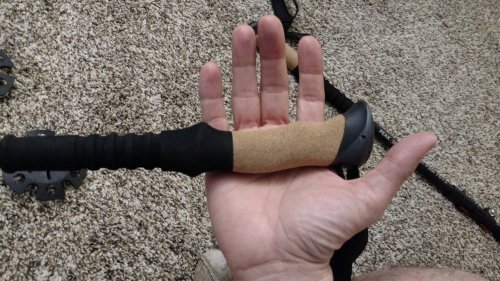 | | Cork Handle vs. Hand |
From a weight standpoint, I checked them again on the next day. Honestly, I did. My measured weight of the poles (without the snow basket or rubber tips but with the performance basket) comes in at more than 2 oz (60 g) from the listed weight. I only use a cheap kitchen scale so perhaps my equipment is drifting a bit and needs to be calibrated.
READING THE INSTRUCTIONS
The poles came without instructions. I would like to think of myself as one of the sharper knives in the drawer and perhaps more observant than the average squirrel looking for a snack. There are days I have my doubts, which usually coincide with the amount of caffeine I've absorbed before 8am. Either way, without instructions and only having limited experience with hiking poles, I am left to the un-engineering world of guesswork on a couple of things.
TRYING IT OUT
First off, changing the lengths of the poles. The red latches are easy to unclip and the poles slide smoothly to the length I want. The poles also have helpful length indicators on them to tell me how far I need to go and obviously, I have to adjust both sections to the same length to get that distance. I set both poles at 115 cm to start. The latch though, flopped loosely until I hand-tightened the screw on the other end. Without instructions, and suffering from my engineering background too much, I was left unsure exactly how tight to make these screws. If I tightened them too much, would it mean I could be stuck at that length or damage the poles or latches? If I made it too loose, could the latch flip open accidentally while I'm hiking and leave me squatting over a knee-high pole? I don't want to carry a torque wrench out in the field, just a little guidance. For now, I'll try to keep them firmly finger-tightened.
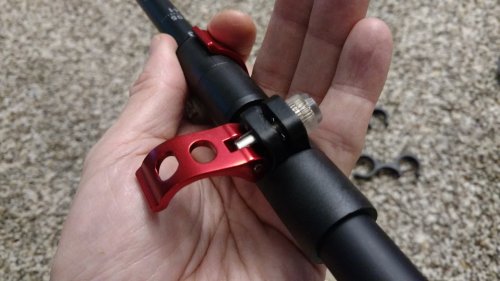 | | Latch System Close-up |
Second off, the snow baskets. I studied these babies for a bit and was unsure exactly how to put them on the poles. To be fair, I've never used snow baskets before and I don't expect to see snow in Michigan in June when I leave next week on my first backpacking trip of the year. But I live in Michigan and the weather is typically a mystery stranger than a bad Scooby-Doo episode. I finally noticed the threads on the inside of the snow baskets. If there are threads on one side, there must be matching threads on the other somewhere for them to mate into. Success eventually at removing, what I'm going to call the performance baskets and screwing the snow baskets in their place. I call these performance baskets because while there isn't a material list. I'm guessing this is correct since both items have threads, they connect at the same place, the poles were shipped with performance baskets included and there aren't any other loose parts. Makes sense to me.
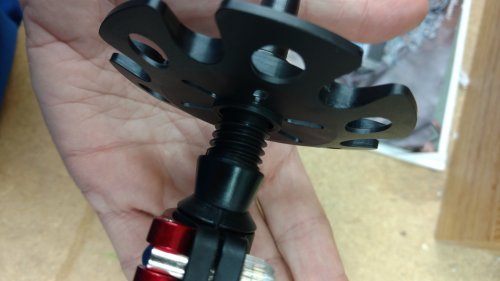 | | Threading the Snow Basket On |
Extending the poles to what I call a comfortable length (upper arm to wrist at a 90 degree angle when holding the poles), I opted to go for a 20-minute walk in the neighborhood to try them out. I used the rubber tips initially as I was walking on sidewalks but when I hit the commons area of our subdivision, I pulled them off to see how the carbide tips felt in the grass and dirt. They had excellent contact with the ground. The cork handles also felt very comfortable. The straps were loose enough to not interfere with my hands or wrists, but they were there if I wanted to use them as supports. Part way through my walk, I decided to tackle a small hill and pushed off. One of the poles suddenly shortened underneath me. I flipped the latch open, reset the length, and this time tightened the screw down first before flipping the latch closed. I'm not sure if that's the correct procedure but it's a lot easier to tighten the screw when the latch isn't down. As I pushed off the second time, the pole held firm. The other pole was fine the way it was, but next time I play with the lengths, I'll adjust the screws first and then flip the latches. Besides this small setback, the poles were solid for the entire hike and felt very sturdy.
As a final note, the poles felt comfortable in either hand; I did not find any preference for a left or right hand pole. But I wonder if I should mark one as R and the other L so that over time, if/when the cork forms to my hands, one of them will be shaped for the right hand and one for the left. While I was studying the poles near the handle to see if there were any markings, I tugged gently on the bottom (loose) end of the strap and the plug holding the strap in place came out and the strap length changed. After confirming this on the other strap, I discovered these poles have the ability to adjust the straps. That's a pretty cool design feature. Looking back on my walk, I think having the straps a little shorter would have helped me use them as wrist supports and I'm pleased that Mons Peak IX included this option.
SUMMARY
Overall, these poles are well-build and feel very solid. They also look beautiful and are well crafted. I like the feel of the cork handles and the latch system. Once I figured it out. I used it to easily change the lengths of the poles. I'm looking forward to giving these a workout in the upcoming months.
This concludes my initial report. The field report will be appended to this report in approximately two months from the date of this report. Please check back then for further information.
I'd also like to thank Mons Peak IX and BackpackGearTest.org for the wonderful opportunity to test the Tiger Paw 7075 trekking poles.
FIELD REPORT
FIELD LOCATIONS AND CONDITIONS
* Trip #1: 2 Days / 1 Night Backpacking - 18 miles on Jordan River Pathway (Alba, MICHIGAN - USA) from May 26-27, 2018. This is a green tunnel-like trail that is heavily forested and runs next to a river for significant portions. The ground is mostly dirt with significant sections of sand underneath and in/along the river. There also small mud sections where springs and streams flow across the trail and multiple open fields and roller-coaster-like hills at times. Peak elevation is 1329 ft (405m). Campsites are situated near the half-way point where we were tent camping. While the temperature typically ranges much cooler during this time period, we had near record-setting weather at 84F (29C) that along with the humidity had a real-feel temperature at 90F (32C) during the daytime. At night, the temperature dropped down to 62F (17C) and we had a minor thunderstorm roll through that dropped 0.23 inches (6 mm) of rain. My pack weighed in at 27.6 lbs. (12.5 kg) which included all food, water and a few luxury items for my wife and me to celebrate our anniversary.
* Trip #2: 7 nights' base camping at Cole Canoe Base (Alger, Michigan USA) from June 23-30, 2018. This is a large scout base camp filled with significant trees. The ground is mostly dirt and the camp is very flat with few hills. I used my hammock to camp. Early it the week, it was cool enough that I needed a sweatshirt, mid-week we had some rain and the end of the week turned into a scorcher. Temperatures ranged from a nighttime low of 41F (5C) to a daytime high of 95F (35C). We had one day of rain that started in the middle of the night and came down until mid-afternoon. I estimate the total precipitation around 0.25 inches (6 mm)
* Trip #3: 5 nights base camping at Blackwoods Campground at Acadia National Park (Bar Harbor, Maine USA) from July 9-15, 2018. This is a large campground with heavy tree coverage within a five-minute walk of the Atlantic Ocean. The ground in camp was mostly dirt with leaves and twigs, while the hiking trails and seashore were covered with both large and small granite rocks. The weather during this time ranged between 48 to 81F (9 to 27C), but it felt much warmer due to the higher humidity. There was, however, no precipitation.
PERFORMANCE IN THE FIELD
Trip #1:
We arrived at the trailhead before 10am on what would turn out to be a hot, steamy weekend. Pulling the poles out of the back of the car, I popped off the two rubber tip "thingies" and tossed them into the car. Based on my previous experience on this trail, the terrain would be more fun than the sidewalks near my house. Learning from my past mistakes, I popped open the latches, tightened down the screws slightly, adjusted the lengths to 120 cm each and snapped them closed. I tested them by leaning on them firmly and all connections felt strong and solid.
My wife gave me a raised eyebrow and asked if I had brought my old trekking poles too. Begrudgingly, I handed off my old set after adjusting them to a good length for her. It would be her first time using poles and if she did not like them, I would be carrying 4 poles out of the back-country. I normally would not mention this except as a side note that some of the trail pictures may show her with trekking poles. She was not using the Mons Peak IX Tiger Paw 7075 Trekking Poles, but I wanted to show some of the terrain and I am the main photographer for our family. I also discarded the idea of tossing her my camera over some of the muddy sections. If she fell in a mud pit while I had my camera out, well, we have been married 19 years now and I would be permitted a brief, soft chuckle. On the other hand, if I fell while she was recording it, I would not want the video evidence.
Over the course of the day, the trekking poles worked great. I really liked how the cork felt on my hands. That was especially important as I had burned my index finger a few days earlier and was starting with a nasty blister right where I would be gripping the handle. The cork never tore into the blister and it was still intact when we arrived at camp several hours later. The poles also remained at the fixed length throughout the trip. I never had that feeling of suddenly being a giant using a wand as a hiking prop like on my initial walk when I did not have the screw tightened enough.
I also found that I was using the lower section below the cork section as well as the top part occasionally to change my grip when going uphill or downhill. I had expected to be adjusting pole lengths, but never needed to. The handles had enough versatility that they worked fine with the initial length I had set them to. I did end up tightening and loosening the straps fairly often, depending on the terrain and what kind of a grip I used, but I could do this easily while walking.
The only downside occurred roughly 5 miles (8 km) into the trip when I looked down after a particularly muddy section and discovered one of the performance baskets was missing. It was definitely there after lunch and had only recently fallen off. We took a short break where I backtracked the last two muddy sections but never found it. I checked the other performance basket and found it was slightly cross-threaded but intact. I unscrewed it, made it straight and then tightened it down firmly before continuing on. The pole still worked fine though the OCD portion of my brain was bothered by the asymmetric appearance of only one with a basket.
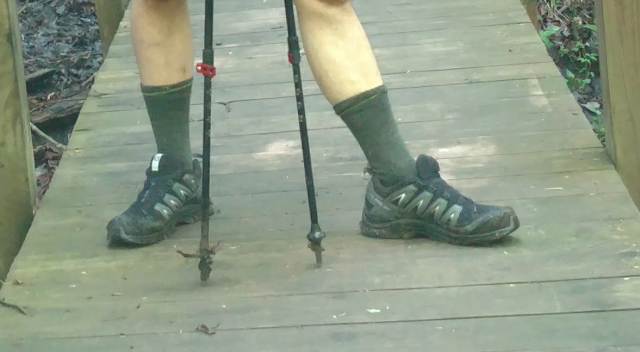 | | Pole on Left is Muddy and Missing Basket |
That night, I shortened the poles to travel mode and stuffed them under the corner of the tent prior to a thunderstorm that rolled through. In the morning, I noticed they were covered with both dirt and sand. They were also soaking wet. I was a bit worried this may cause some binding, but they slid back smoothly to the desired length without any obvious problems.
The second day hiking was similar to the first except that I did not lose the remaining performance basket. The Tiger Paws worked great to take the load off my knees and back. It was equally hot on this day and we made good time and finished the trail before 3pm. I did not fall, the poles did not collapse suddenly and I had a good solid grip. The straps continued to comfortably support my wrists so I was not gripping the handles so tightly. I never developed any blisters - all of which are great outcomes. Nor did the blister I started the hike with rip open. Finally, I did not notice any preference for a specific pole going in a certain hand. I plan on monitoring this in the long-term testing but any shaping done by my hands was either done equally or negligible over this trip.
As a final note, if anyone is wondering, my wife now has claimed use of my old trekking poles and begrudgingly admits how necessary and useful they were for stability in some of the rougher sections. There is also absolutely no video evidence of anyone falling in the mud. There was also absolutely no chuckling on my part.
Trip #2:
Although this was a base-camp only and I did not go on any hikes requiring poles, I did use them for my setup. Each morning or when the weather turned very hot, I would convert my tarp into porch mode and use the poles to prop up the edges. This allowed me to see out as well as provide significantly more airflow. To accomplish this task, I would extend the poles to their fullest length, set the cork handle end down into the dirt and direct the carbide steel tip into the triangle connection on my tarp. At night or if the weather hinted at heavier rain, I removed both poles and dropped the tarp down tighter to the ground. For storing the poles overnight, I always reduced them to travel length as I did not want to have them accidentally damaged by someone stepping on them in the dark. I estimate that I changed the lengths at least twenty times over the course of the week.
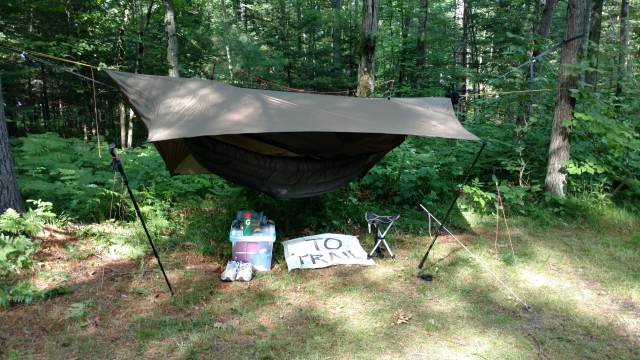 | | Hammock in Porch Mode |
The one issue I had was the pole that was missing the performance basket was difficult to manage with the tarp's triangle ring. It kept slipping through the hole where the basket's larger size prevents this on the other pole. I resolved the issue by putting a hole in an orange juice cap and using that as an impromptu basket. Obviously this would not work for hiking and I want to get a replacement performance basket.
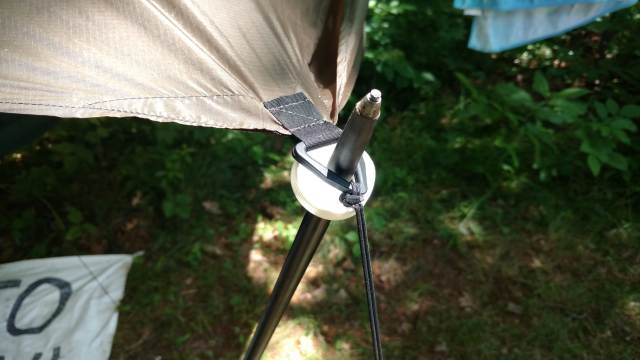 | | Orange Juice Cap Solution for Missing Basket |
Trip #3:
The poles packed up easily in the car for the long haul to Maine. I did not have my camping hammock or tarp, but I did use them for one really good day hike. The trek was from near sea level to the top of Cadillac mountain (elevation near 1500 ft / 457 m) and back down again over a distance of 7 miles (11.3 km). The terrain is granite boulders embedded in the ground combined with lots of looser small rocks and pebbles. The trail includes multiple rock scrambles both uphill and downhill and occasionally has metal rungs embedded into the stones to aid hikers. I found hiking poles absolutely essential for me. They gave me additional stability while also taking some of the pressure off my knees (especially on the downhill). I had the added advantage of having my old trekking poles along for the trip which I gave to my daughter. Part way through the hike, I switched to my old set (and handed the Mons Peak IX Tiger Paws 7075 to her) so I could do an immediate comparison.
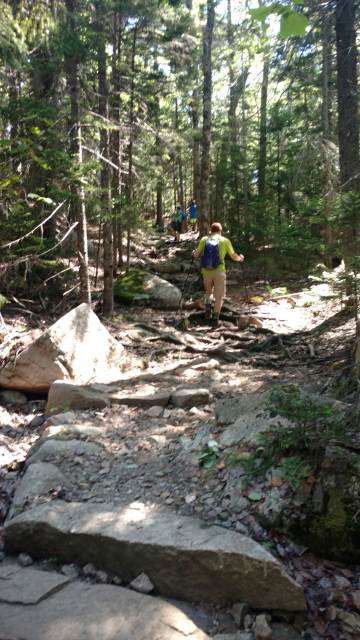 | | Acadia Trail to Top of Cadillac Mountain |
I really liked the cork grips on the Mons Peak IX Tiger Paws 7075. I found I actually preferred them over the foam grips on my old poles. The grip was solid and I did not experience any rubbing or hot spotting on my hands. The weather during the hike was also hot, especially on the rock section near the top that meant we were fully exposed to the sun. This lead me to sweat significantly, but I never lost my grip on the poles.
I also appreciated the straps and multiple grip sections on the poles. I used the top of the poles to support my body while tackling technically difficult downhill sections. I also used the section lower than the main grips on uphill areas.
Another important note was the dependability of the snap-click locks. In my initial trial just after I received the poles, I had one of them slip on me until I adjusted the screw correctly. The locks for this hike never once slipped and the poles held their length the entire way. I did not think about this during the hike but only reflected on it afterwards. I was really pleased with how they performed in these sections because if they had suddenly slipped on one of the downhill areas, I would have fallen. I was trusting the poles with halting the majority of my weight coming off the rocks.
I did use the rubber tips for the majority of the hike. They were quieter and provided a better surface grip than the carbide tips against the rocks. They did show some wear on the rubber but never punctured through the ends. The wear was expected and I would call it normal.
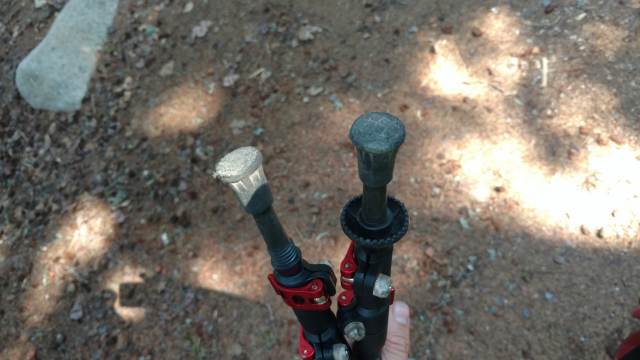 | | Wear on Rubber Tips |
As a last note, I never had a problem with the pole that had the missing performance basket. I am still going to get a replacement set to make sure my hammock tarp sets up in porch mode correctly and, of course, because I suffer a bit from OCD and really need them to match. I checked the other pole post hike and the performance basket was tight and showed no signs of coming off.
SUMMARY
Overall, I really like the Tiger Paws 7075 Trekking Poles. I think the deciding factor for me is the cork handles. They have a great feel to them and the multiple sections in the handle allow me to switch my grip based on the terrain without constantly fiddling with the set lengths. I also like how the strap lengths adjusted very easily on the go and supported my wrists during extended hikes.
Lastly, the poles have a solid feel to them during use that gives me confidence that they will hold my weight without suddenly coming loose.
POSITIVES
1. Cork felt great on hands. No blisters, sliding or pain.
2. Height adjustments held-up throughout trip.
3. Straps were easy to adjust lengths to match grip
NEGATIVES
1. Weigh a little heavier than reported on website
2. No instructional manual to clarify how to use latching system
3. Performance basket came loose over time and fell off
FINAL NOTE
This concludes my Field Report. Thank you to both BackpackGearTest.org and Mons Peak IX for allowing me to test the Tiger Paw 7075 Trekking Poles. The Long-Term Report should be completed within 2 months. Please check back then for further information.
LONG-TERM REPORT
LONG-TERM TEST LOCATIONS AND CONDITIONS
Summary: Over the last two months, I have used the trekking poles on an additional 2 backpacking trips, 1 base-camping trip and 1 shakedown day-hike.
* Pre-Trip Shakedown Hike - 5 miles (8 km) at Maybury State Park (Northville, MICHIGAN - USA) on July 22, 2018. Terrain is compacted dirt and clay. There was heavy tree coverage throughout the entire hike. The temperature was 75F (24C). While it looked gray and was threatening to rain, it never did. For this hike, I carried a 30 lb. (13.6 kg) backpack and we hiked very fast with a pace of over 3 mph (4.8 kph).
* 5 Days / 4 Night Backpacking - 23 miles (37 km) at Pictures Rocks National Lakeshore (Munising, MICHIGAN - USA) from August 1-5, 2018. This is a scenic backpacking trail running next to Lake Superior. The trail is mostly under forest coverage and runs atop cliffs and along a beach. The terrain is sand with a heavy amount of sandstone and other rocks. We did a small section where we put in at Little Bear Lake Campground and hiked between multiple group sites (Lowney, Coves and Mosquito) and ended at Miner's Castle. Temperature for the week ranged between 49-64F (9-18C) at night to 57-80F (14-27C) during the day. It rained three times during the trip. The first was while we were hiking on day 1, then early in the morning while were sleeping on day 2 and lastly after breakfast while we were in basecamp of Day 4. As this was for supporting a Boy Scout troop trip, my pack weight came in at a hefty 41-45 lb. (19-20 kg) including food, water and camping gear. For most of the trip, we hiked at a pace I am estimating at 1.5 mph (2.4 kph). I hammock camped every night.
* 3 Days / 2 Night Backpacking - 18 miles on Jordan River Pathway (Alba, MICHIGAN - USA) from August 11-13, 2018. This is a repeat of the trip I went on in May with my wife. This time, I took several college buddies. In the past, I have done this as an overnight trip, but we extended the trek by a day in camp to relax and play games. Temperature ranged from mildly chilly nights (55F / 13C) to hot days (85F / 29C). There was no rain during this time. My pack weighed near 25 lb. (11 kg) including all food, water, camping gear and games. For most of the trip, we hiked at a pace faster than 2 mph (3.2 kph). I hammock camped every night.
* 3 Days / 2 Night Base Camping - at Private Grounds (Farmington Hills, MICHIGAN - USA) from August 31 to September 2, 2018. This area is moderately covered with trees. The ground is dirt with a heavy mix of tree roots. Daytime temperatures were near 90F (32C) while nighttime cooled off to around 70F (21C). We had a nice thunderstorm during the daytime and gentle rain throughout the second night. I estimated the water accumulation at 0.2 inches (0.5 cm) and the wind gusts up to 30 mph (48 kmh). I hammock camped both nights.
PERFORMANCE IN THE FIELD
For the last two months, I have gotten some great opportunities to use the Mons Peak IX Tiger Paw 7075 Trekking Poles. For all of the trips, they did a great job and never failed me. They have been used as both hiking aids to improve my stability and to take the load off my knees. But they came in especially handy to prop my hammock tarp up into porch mode which improved ventilation and visibility.
For the Pictured Rock trip, trekking poles were especially important. The Boy Scout motto I learned when I was younger was "be prepared". That meant for some crazy reason that I ended up carrying a load in my pack that was nearly double what I prefer to carry. This included troop food and gear for 22 individuals. No, I did not carry all of that for 22 people, it just felt that way at times. The poles did a great job saving my knees and back. I twisted my ankle slightly near the end of the trip where I had to cross a downed tree and was not able to brace myself properly. I am convinced the poles kept me upright, where the heavy load I was carrying could have sent me down to the ground and created a much worse injury. The pole not only took the full brunt of my weight without the latch system failing but also did not bend.
For propping my tarp up, I always extended the poles to their maximum length. I put the handles down into the sandy ground and set the tips in the triangular pull-outs of the tarp. This allow me greater visibility and ventilation if I was sitting or lying in my hammock. During one of the last days, we had a rainstorm roll through camp just after breakfast. I found it very amusing to sit quietly in my hammock and watch the scouts all try to stand under a (poorly-hung) tarp. At night, I removed the poles, dropped them down to their smallest length and hung them from my hammock tree-strap. This gave me more privacy in my hammock.
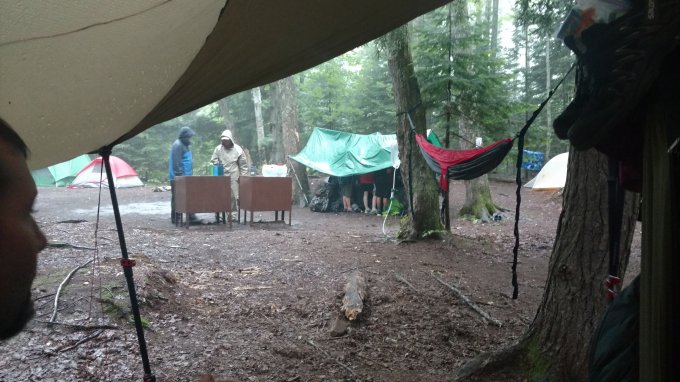 | | VIEW OF SCOUTS HIDING UNDER TARP |
One additional note from the Pictured Rocks trip is that I really do need to replace the missing performance basket that was lost earlier. The terrain in this area is filled with soft sand and that pole would occasionally sink deep into the sand where the other pole stayed closer to the surface. The sand also got into the shaft of the pole and caused some significant scratches to the paint near the base. All of these issues are minor but worth noting. Thankfully, Mons Peak sells extra performance baskets but I have not put in an order yet. I did try threading in one of the mud baskets from my older (non-Mons Peak) poles but the threads did not match up.
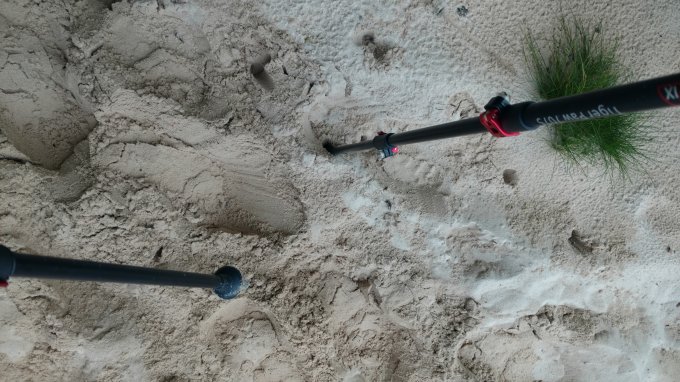 | | PICTURE OF POLES SINKING INTO SAND |
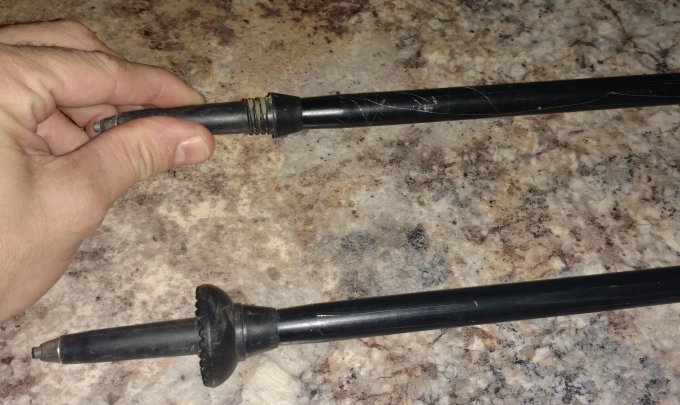 | | PICTURE OF SCRATCHES ON POLE |
For the last trip to Jordan River Pathway (my second time this year!), I went with several of my college friends. They also had trekking poles and for a short time we exchanged equipment to make some comparisons. It only took me a few minutes to determine I preferred the Tiger Paw 7075 poles because of the cork handles and the rigidity they had on the trail while hiking. In camp, the poles did not get used to prop up my tarp as the weather was excessively hot with no threats of rain. For the first time ever, I never ended up deploying my tarp.
For the additional base-camping trip, the trekking poles were used solely for keeping the tarp in porch mode. At night, this was critical for me as the temperature was very warm with a light, misting rain and nearly zero wind. With the tarp propped up on the sides, I was able to keep cool and stay dry. As the poles were exposed to the elements, especially a good thunderstorm during the next day, they got excessively wet. Only the straps retained any of the water and they dried out within an hour.
DURABILITY
Concerning durability, the poles have held up well against a pretty good beating over the 4 months I've tested them. They have seen rock, mud, sand and salt and while they show some wear toward the bottom edges, they still perform well and look good. The tips - both the rubber and the carbide - both show minor wear. The poles have also saved me from one bad fall and at least a couple of other stumbles. Although some sand had worked into the shafts at one time, that debris has either washed away or worked itself out. The poles still slide smoothly and lock into place easily.
SUMMARY
Overall, I am very pleased with how the Mons Peak IX Tiger Paw 7075 Trekking Poles performed throughout this test. While I was disappointed that one of the performance baskets fell off, after I hand tightened the remaining one, I did not have any additional issues with this one loosening. I have found the cork handles fit my hands quite nicely and I prefer them over my old foam-handle poles. I also have not had any trouble with the latching system. The lengths are easy to change and once re-latched, the poles have not loosened (other than when I first tried them out). I am happy to say I will be using these poles over my old poles for future backpacking trips.
This concludes my Field Report. Thank you to both BackpackGearTest.org and Mons Peak IX for allowing me to test the Tiger Paw 7075 Aluminum Trekking Poles.
This report was created with the BackpackGearTest.org Report Writer Version 1.
Copyright 2018. All rights reserved.
Read more reviews of Mons Peak IX gear
Read more gear reviews by Robb Pratt
|




